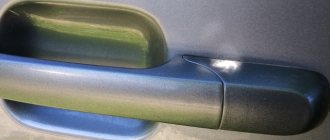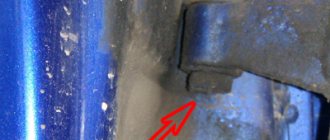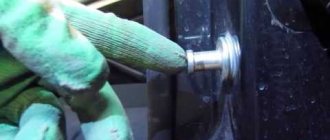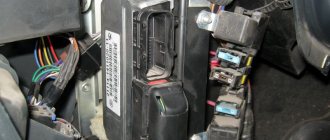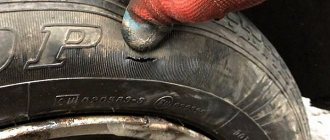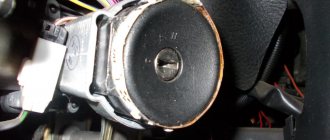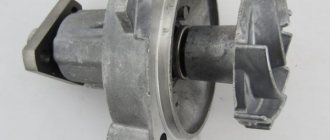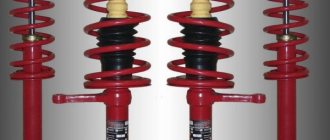The driver parking assistance system, installed by the manufacturer on domestic cars, appeared relatively recently. It allows you to avoid collisions with obstacles when parking the car. But after some time, drivers are faced with incorrect operation, or even complete system failure. Although there is nothing complicated about this device, it still requires special attention to maintain its functionality. Let's talk about possible parking sensor malfunctions and ways to eliminate them.
Problem with the control unit
If during diagnostics five beeps sound or the system is completely silent, then the fault lies in the control unit. It is located in the left rear fender, under the trim. To get to it, you need to remove part of the wing trim and unscrew the fasteners. Most often, blocks cannot be repaired and must be replaced. Since the luggage compartment is often damp and cold, this significantly reduces the life of the control unit. But let's leave this to the conscience of the engineers and move on to the next reason.
How to determine that the parking sensors have stopped working?
Determining that the parking sensors have stopped working is quite simple. If your car has a parking sensor installed from the factory, there is an indicator on the dashboard that will indicate that it is broken. But if you installed an acoustic parking system yourself, then in order to identify a breakdown you should observe its operation. It will either be constantly silent until you crash into something, or it will constantly give signals about non-existent obstacles. But recognizing what exactly has gone wrong is a little more difficult.
Sound off
Some Lada Vesta owners complain about the lack of sound from the system, while the screen works quite normally. It should be noted that you can disable parking sensor alerts in the sound menu if it is very annoying. But this is not recommended, because looking in the mirrors and at the same time at the screen when parking is extremely inconvenient.
When operating a Lada Vesta with parking sensors, you should adhere to certain rules: monitor the condition of the sensors, avoid contact with a direct stream of water (especially when washing with high pressure), listen to unusual alerts. Then you can be sure that you will not accidentally encounter an unexpected obstacle due to a failure of the parking assist system.
Share this article with your friends:
Diagnostics and repair methods
The main function of the parking radar is to inform the driver about an obstacle behind or in front of the car.
If the device does not produce any signals or produces signals with errors, you need to understand the reasons and eliminate them, but first you should carry out a comprehensive diagnosis.
Sensor check
If the radar worked before, but suddenly stopped, the first thing to do is check the condition of the ultrasonic sensors - they may be dirty or dusty. When cleaning sensors, pay attention not only to the elements themselves, but also to the installation point. It is important that the sensor mount is secure.
If cleaning does not produce results, then you should make sure that the elements are in good condition. Checking this is quite simple - the driver needs to turn on the ignition and then touch each sensor with a finger. If the sensor is working, it will vibrate and crackle. If nothing crackles when touched with a finger, then the sensor is replaced with a new one. Sometimes sensors can be repaired.
If you can use your finger to determine which of the sensors on the bumper is not working, then before taking more serious action, you should dry the element thoroughly. Sometimes, after thorough drying, the sensors begin to work. If this does not happen, then you can check the element with a multimeter.
Related article: All ways to turn off the alarm in a car without a key fob
The sensor has electrical contacts - some models have two and some have three contacts. The left one on most elements is “mass”. The tester is switched to resistance measurement mode. One probe is connected to ground, and the second to the second contact.
If the device shows that the resistance is greater than zero and not equal to infinity, then the sensor is in working condition. In all other cases, the sensor is faulty and requires replacement.
You can also check the wiring using a multimeter. To do this, check all the wires that connect the sensor to the control unit. If a break or other faults in the electrical circuit are found, then the wiring for a specific sensor needs to be replaced.
Control unit diagnostics
The unit is reliably protected from moisture and dirt and very rarely fails - it is installed inside the car, and all wiring from the sensors is connected to it using wires or wirelessly.
If problems occur, you can remove the printed circuit board and visually diagnose it - if damaged capacitors or resistors are visible, they can be easily replaced with available analogues.
Checking the metallized strip of the parking radar
As for metallized tapes, everything is much simpler. The tape has a simple, if not primitive, device - malfunctions can only occur due to physical damage.
The entire diagnostic process comes down to a thorough visual inspection. You need to pay attention to even minor defects - scratches, cracks.
Note: Lambda probe, what is it, signs of malfunction and methods of checking
If the integrity of the tape is not broken, then it is recommended to look for the causes of the malfunction anywhere, since the tape has nothing to do with it.
Secret options of the Vesta on-board computer
The Lada Vesta on-board computer is located under the speedometer and contains several secret functions that are invisible when you first use the car. Thanks to it, it becomes possible to disable, change or reduce the sounds of the turn signals on the Lada Vesta.
Lada Vesta on-board computer
The functions of the on-board computer include analysis of the main technical indicators of the car, as well as synchronization of the interaction of other electronic devices of the car. Using it, the driver can quickly configure various aspects of the vehicle’s functioning, as well as instantly receive information on key performance indicators. Navigation and interaction with the computer is carried out using two mechanical buttons with up and down arrows.
Determining the cause of the malfunction
Parking sensors are necessary to detect the presence of obstacles behind the car. They can be either stationary or suddenly appear behind a car: for example, it could be a pedestrian or another vehicle.
If there is a malfunction, the system may either not notify the driver about an obstacle at all, or do it incorrectly: for example, it will respond only to large objects, and may not respond to posts and stones located behind the car. In addition, the parking sensors can notify you late when an obstacle is too close.
If the parking sensor does not work correctly immediately after installation, it may be defective or incorrectly installed. Unskilled craftsmen quite often place the sensor in the wrong place or do not connect the system elements well enough. This should be checked immediately after installation.
When SHOULD it fire?
Normally, the parking radar should turn on automatically when you engage reverse gear. If sensors are also installed on the front bumper, then the system is activated when the vehicle speed drops below 20 km/h.
But there is one caveat! The parking sensors should only beep when there are obstacles. If the parking or traffic zone is “clear”, the sensors should be silent.
Ultrasonic parking radars are more common in our country. They work like echo sounders. The locators emit short ultrasonic pulses, the latter are repelled by obstacles and return to the sensors. The control unit calculates the distance to the object based on the speed of sound in the air (which is always constant). The closer the car gets to the obstacle, the more desperately the gadget beeps. If you get closer than 15 cm, as a rule, the squeak turns into a continuous signal that cannot be ignored.
So why does the parking sensor beep constantly, immediately when you engage reverse gear, even if there are no obstacles in its range of action? What will be the answer to the logical question: what did the ultrasound push off from if there are no objects around?
Let's try to figure it out!
How to adjust the volume of turn signals on Vesta
Once in the secret menu for controlling the sounds of the turn signals, you can adjust their volume using the same arrow buttons.
The up arrow key increases the volume and the down arrow key decreases the volume.
The up arrow key increases the volume, and the down arrow key decreases the volume. In the case of the volume of the turn-on signal, we are talking about P1 mode, where you can use the arrows to increase or decrease the sound of the turn signals on the Vesta. The shutdown sound in P2 mode is adjusted in the same way.
Best driving instructors:
Automotive instructor Svetlana Automatic transmission: Hyundai Accent Trains in Northern Administrative Okrug, North-Western Administrative Okrug, Khimki REVIEWS
Driving instructor Elena Automatic transmission: Chevrolet Lacetti Manual transmission: Chevrolet Lanos Trains in the Southern Administrative District, South-East Administrative District, Vidnoye, Domodedovo REVIEWS
Driving instructor Marina Automatic transmission: Kia Cerato Manual transmission: Chevrolet Lanos Trains in Northern Administrative Okrug, Dolgoprudny REVIEWS
Driving instructor Elena Automatic transmission: Kia Cerato Manual transmission: Chevrolet Lanos Trains in Northern Administrative Okrug, North-Western Administrative Okrug, Khimki REVIEWS
Driving instructor Natalya Automatic transmission: Kia Spectra Teaches in the Eastern Administrative District, Balashikha, Reutov REVIEWS
Driving instructor Oleg Automatic transmission: Chevrolet Lacetti Manual transmission: Chevrolet Lanos Trains in Northern Administrative Okrug, Dolgoprudny REVIEWS
Driving instructor Yana Automatic transmission: Kia Spectra Teaches in the Northern Administrative Okrug, Dolgoprudny REVIEWS
Driving instructor Yulia Automatic transmission: Chevrolet Lacetti Manual transmission: Chevrolet Lanos Trains in the Eastern Administrative District, South-East Administrative District, Lyubertsy, Reutov, Zheleznodorozhny REVIEWS
Automotive instructor Svetlana Automatic transmission: Chevrolet Lacetti Trains at Northwestern Administrative Okrug REVIEWS
Driving instructor Tatyana Manual transmission: Chevrolet Lanos Automatic transmission: Kia Spectr Teaches in Krasnogorsk REVIEWS
Driving instructor Peter Manual: Daewoo Nexia Trains at Northwestern Administrative Okrug REVIEWS
Automotive instructor Oksana Automatic transmission: Hyundai Accent Teaches in North-Eastern Administrative District, Mytishchi, Korolev, Pushkin REVIEWS
Driving instructor Dmitry Automatic transmission: Volkswagen Golf Manual transmission: Chevrolet Lanos Trains in North-East Administrative District, Northern Administrative District, North-Western Administrative District, Dolgoprudny REVIEWS
Driving instructor Oksana Automatic transmission: Kia Spectra Manual transmission: Chevrolet Lanos Trains in the Southern Administrative District, South-Western Administrative District, Vidnoye, Podolsk REVIEWS
Automotive instructor Dmitry Manual transmission: Lada Granta Teaches in the South-East Administrative District, Lyubertsy REVIEWS
Which model to choose
The operating principle of parking sensors is based on the reflection of an ultrasonic signal from an obstacle and its reception by the sensor. Their number determines the size of the controlled area. The more sensors, the fewer blind spots behind the car. Due to the fact that the power of the emitters is low, the parking sensors can detect an obstacle at a distance of 2-2.5 m. The change in the distance to an object for different models is fixed from 1 to 10 cm, and the minimum operating distance of the radar is 10-30 cm. The characteristics and quality of parking sensors depend on the manufacturer.
Frosty weather
One of the common situations is that the parking sensors constantly beep in the frosty and snowy seasons. This occurs due to the accumulation of ice and snow on the car bumpers. The simplest thing is to clean the sensors from ice and foreign contaminants.
If it is not possible to restore functionality using a simple method, the reason may be the freezing of the liquid that forms on the surface of the parking sensors. Place the machine in a dry, heated area to thoroughly dry the electronics.
Tips for motorists
The driver parking assistance system, installed by the manufacturer on domestic cars, appeared relatively recently. It allows you to avoid collisions with obstacles when parking the car. But after some time, drivers are faced with incorrect operation, or even complete system failure. Although there is nothing complicated about this device, it still requires special attention to maintain its functionality. Let's talk about possible parking sensor malfunctions and ways to eliminate them.
Functional highlights
The system is supplied by the manufacturer with a camera, transmitting and receiving units. The video image enters the transmitter unit, which sends data to the receiver. The picture is displayed on the monitor, helping the driver to park close to other cars, eliminating “blind spots”, without touching other people’s vehicles. Sealed rear view cameras and infrared illumination have a beneficial effect on parking at night. The best option is a harmonious union of the camera with the electronic system. This is the ability to recognize obstacles when sensors cannot cope with this task.

